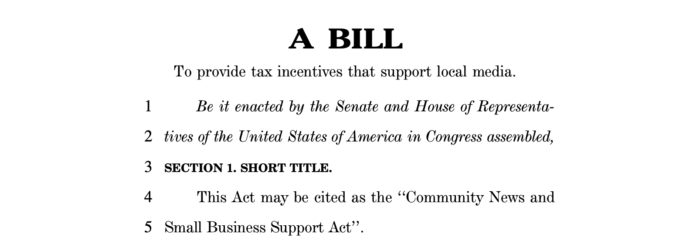
Communities with less local news see more government corruption, more government waste, and higher taxes. Civic engagement, voter turnout, and voter knowledge all decrease as local coverage declines. Small and rural communities are the most likely to be affected by local news deserts. But attitudes about the press are sharply polarized in the United States and federal aid for local news has not enjoyed equal support across the aisle.
Enter the revamped Community News and Small Business Support Act.
An earlier version of this federal bill — the Local Journalism Sustainability Act — enjoyed some bipartisan support in the U.S. House of Representatives but ultimately floundered in 2021. Last week, a conservative Republican teamed up with a Democrat to introduce a version that’s been reworked and renamed to emphasize its benefits to small businesses and local communities.Steven Waldman, chair of the nonpartisan, nonprofit Rebuild Local News Coalition and cofounder of Report for America, hailed the rewritten bill “a conceptual and political breakthrough.” In an op-ed for Editor & Publisher, Waldman wrote: “It makes sense because saving local news should not be about saving journalism jobs per se. It should be about strengthening communities. Politically, if we are to succeed, we need to expand our group of friends beyond other journalism trade groups.”
Co-sponsor Claudia Tenney, a Republican representing the 24th congressional district in New York, has first-hand experience in journalism. She previously served as the owner and publisher of local newspapers including The Mid-York Weekly, which was founded by her grandparents and printed its last issue in September 2022, and what she has described as the first Black, Latino, and Bosnian-language newspapers in the region. She also boasts strong conservative Republican creds and was endorsed by Donald Trump in 2022.
The Community News and Small Business Support Act ensures that local newspapers can continue to deliver vital news stories that matter most to our communities while allowing for these small businesses to grow.
Read more on this bill here: https://t.co/lrRk8XQDaf
— Rep. Claudia Tenney (@RepTenney) July 21, 2023
So what’s in the new bill?
The Community News and Small Business Support Act would create two types of tax credits for five years. A third credit included in the earlier Local Journalism Sustainability Act, an individual tax credit for news subscriptions, has been struck. Co-sponsor Suzan DelBene, a Democrat representing Washington State, said its implementation would have been “very, very complicated.”
The advertising tax credit gives small businesses (defined as those with 50 or fewer full-time employees) up to $5,000 in the first year and $2,500 in subsequent years to advertise with local media. Traditional ads in local newspapers, digital news sites, and radio and television stations are eligible, along with the “sponsorships” offered by nonprofit newsrooms. The tax credit is structured as a partial reimbursement. That means, for example, small businesses would need to spend $6,250 in the first year to get the full $5,000 credit and only businesses that earn enough to pay taxes in the first place are eligible.
Proponents believe investing some decision-making power in the hands of local business owners — and not, say, some “expert” committee in Washington, D.C. — will broaden the appeal. Like the federal postal subsidy for newspapers before it, this legislation was designed to be content-neutral.
“This forces those of us advocating public policy to confront this reality: any public policy to help local news has to support a wide variety of local news outlets,” Waldman wrote. “If a local small business wants to spend its ad dollars with the local Fox TV affiliate, progressives should accept that. And if they want to spend it on the local news nonprofit, conservatives should also nod along. That makes it First Amendment-friendly and able to solve the problem on a large scale.”
The bill’s payroll tax credit would be more consequential for the local news industry. For local reporters making up to $50,000 a year, this refundable credit would cover half of the salary for the first year and 30% in the remaining years. The Rebuild Local News Coalition calculated the tax credit would be worth up to $85,000 per journalist over the length of the bill.
That kind of money would go a loooong way to helping local outlets hire (and retain) journalists. Newsrooms would be rewarded for reinvesting in reporting, too, with more tax credits available to those who put the savings towards hiring more journalists. Proponents of the bill have (perhaps optimistically) argued the incentive would encourage the largest local newspaper owners to think twice about their cost-cutting ways.
The revised bill also includes new language to prevent wholly partisan or “pink slime” outlets from cashing in, including a provision that news organizations will not be eligible if they are controlled by — or receive more than $100,000 a year from — groups such as political action committees, labor unions, chambers of commerce, or “social welfare” advocacy groups. To qualify, newsrooms must also employ at least one full-time local news journalist who lives in the community.
In an analysis of similar tax credits introduced in Canada, researchers at the University of North Carolina’s Center on Technology Policy noted local advertising tax credits, in particular, were “more politically appealing” than other tax credits that benefit local journalism.“At the federal level, lawmakers have framed news tax credits as key to protecting democracy through a healthy press,” the report noted. “This is a worthy goal, but given widespread partisan mistrust of the press it is unlikely to be broadly appealing across party lines. A potentially stronger framing would be to cast the credits as a benefit for small business owners and the broader community.”
The sponsors of the Community News and Small Business Support Act appear to agree. Local newsrooms and their champions will have to wait and see if the makeover nudges the bill into law. You can read the text of the H.R.4756 bill here.